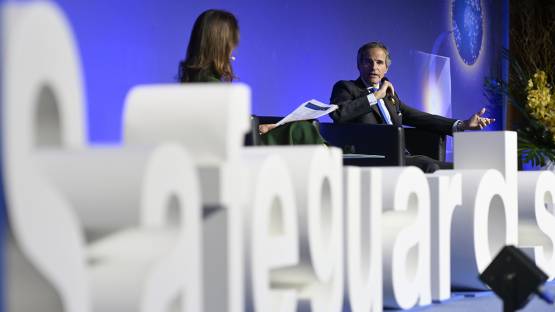More than 600 stakeholders in support of IAEA safeguards – diplomats, officials from State regulatory authorities, the research and development community, industry and civil society – are meeting this week in Vienna for the 14th Symposium on International Safeguards. The week-long Symposium, which began this morning, provides a forum to identify challenges and opportunities in safeguards, cultivate partnerships, and showcase research and ideas in support of the verification of the peaceful use of nuclear material.
This year’s Symposium happens during a milestone year – it celebrates the 50 years of comprehensive safeguards agreements (CSAs) and 25 years of additional protocols (APs). Under a CSA, a country is required to declare to the IAEA all nuclear material in all peaceful activities, and the IAEA is obligated to ensure that safeguards are applied to verify that such material is not diverted to nuclear weapons or other nuclear explosive devices. The AP broadens the IAEA’s access to information and locations in countries with CSAs in force, strengthening the Agency’s detection capabilities.
“This year’s Symposium reflects on the past, to understand how and why we have got to where we are, and seeks to anticipate the future, assessing where we want to go and what we need to do to get there,” said Massimo Aparo, Deputy Director General and Head of the IAEA Department of Safeguards, during his opening remarks. “In light of this reflection and anticipation, we need to identify the actions necessary to ensure the safeguards system remains fit for purpose in the years ahead.”
The emergence of new nuclear facilities and renewed interest in nuclear power require novel safeguards approaches. “Improving efficiency alone will not be sufficient,” Mr Aparo said. “We must also become more effective – effective at ensuring the non-diversion of nuclear material from peaceful uses, and effective at providing credible assurances of the absence of undeclared nuclear material and activities.”
The Symposium is being livestreamed and is also accesible through the IAEA Conferences and Meetings app, available on the App Store and Google Play.
At the opening session, IAEA Director General Rafael Mariano Grossi took part in one-on-one conversation with journalist Barbara Serra, discussing the implications of the conflict in Ukraine on nuclear safety and security, the IAEA’s role in the JCPOA — sometimes referred to as the ‘Iran nuclear deal,’ safeguards activities during COVID-19 and how nuclear can help address energy security. He also touched upon ways of adapting safeguards for naval nuclear propulsion and the opportunities and challenges of new technologies. Regarding the situation in Ukraine, Mr Grossi said: “What is important is for the IAEA to be ready to act in a timely manner – projecting, at the same time, the indispensable, professional, impartial and technical approach.” Mr Grossi also reiterated his call to establish a nuclear safety and security protection zone around Ukraine’s Zaporizhzhya Nuclear Power Plant.
In regards to energy security and access to nuclear power, Mr Grossi explained how the IAEA and its safeguards activities serve as an enabler. Safeguards enable this indispensable tool – nuclear energy – for global decarbonization, he said. Last week at the International Ministerial Conference on Nuclear Power, Mr Grossi made a global appeal to advance nuclear energy, amid climate change and the ongoing energy crisis.
In line with the Symposium theme, the opening day also featured two key note speakers: Pulitzer prize winning author and historian Richard Rhodes and Saadia Zahidi, a Managing Director at the World Economic Forum. Two panels, featuring representatives from IAEA Member States, the research and development community, industry, civil society and former IAEA officials, considered the lessons for safeguards from the past and the application of these into the future.






